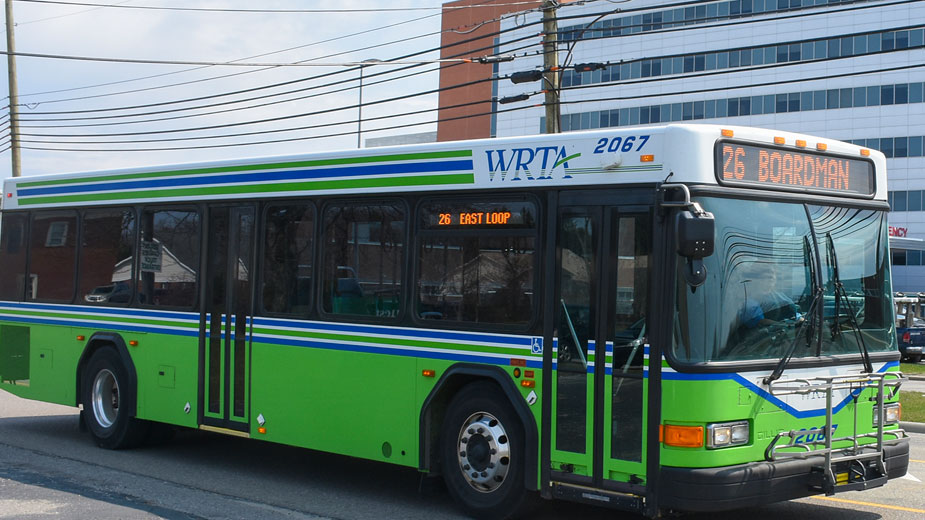Market Street Transit Plan Promotes Development, Expands Transportation Options
YOUNGSTOWN, Ohio – A plan being developed to reorient transit to promote development along Market Street in Youngstown and Boardman Township could serve as a template for similar efforts in other key corridors.
Mixed-use properties, extending Western Reserve Transit Authority’s Market Street route to St. Elizabeth Boardman Hospital and a revisioning of Federal Station were among the concepts in a draft proposal outlined to community stakeholders Monday afternoon during the first of two scheduled virtual public forums.
In 2020, WRTA received a $250,000 U.S. Department of Transportation grant to develop a comprehensive transit-oriented development – or TOD – plan for the Market Street Corridor in Youngstown and Boardman.
“It’s a way of trying to enhance transportation connections,” said Dean Harris, WRTA’s executive director.
The three objectives of the transit-oriented development plan are to promote development, expand transportation options and improve quality of life, according to Tim Rosenberger, a consultant with WSP, a leading global engineering consulting firm WRTA hired.
“What we found around the country is that when transit is put in place with development, when development is modified or is oriented to serve in transit, it really leads to thriving communities,” he said. “It leads to attractive development that really works for people who live and work in those communities.”
Other corridors where such plans are being contemplated include Mahoning Avenue, Belmont Avenue and Glenwood Avenue.
WSP is in the final stages of completing the plan, which is due to be presented to WRTA’s board of directors in April for its approval, Harris said.
The elements of TOD include making it easier for the people who use pubic transportation to access it with sidewalks, crosswalks and other amenities; promoting mixed-use space with retail, office and residential, which leads to more vibrant, active neighborhoods; and creating higher-density spaces.
“This is consistent with the way Market Street was built originally back around the early 1900s, late 1800s,” he said. “This was very much the way that it was developed with generally businesses on the first floor and many cases on the second floor, retail businesses and then other types of development either apartments, hotels, or offices above, sometimes several of those are all mixed in together. This is also something that’s increasingly common.”
Under the proposal outlined Monday afternoon, the new Market Street route would have eight scheduled stops at shelters and no longer terminate at Southern Park Mall – instead, it would run to St. Elizabeth Boardman Hospital. The Glenwood and South Avenue routes potentially could be retimed to meet at Southern Park Mall for transfers.
“We’d also like to, at some point, reduce the time between buses on Market Street,” Rosenberger said. “Right now buses come every 30 minutes. We’d look at increasing that to 20 minutes or maybe even 15. But that would be based on attracting more riders and probably after new development came into the corridor.”
Rosenberg presented other concepts in the overall plan with his colleagues from Environmental Collaborative, a community engagement consultant. Those concepts include constructing a new enclosed bus terminal modeled on Grand Rider Transit Station in LaCrosse, Wis., as well as converting the outer lanes north and south on Market to be primarily shared by buses, bicycles and delivery vehicles, or for right-turning vehicles. Shelters would be upgraded and with better lighting and bollards to prevent vehicles from crashing into them.
Additionally, vacant properties along the corridor could be rezoned to permit a wider range of uses to help extend development into the neighborhoods east and west of Market Street corridor. Officials would also work with the Mahoning County Land Bank, Community Corrections Association and other landowners to package properties for development, particularly for meeting neighborhood needs such as food and health-care access.
“There is no full-service grocery store on Market Street anywhere in Mahoning County,” Rosenberger said. “So if you are tied to the bus and you’re unable to walk all the way over to South Avenue to get to a full-service grocery store, you have to transfer buses.”
He also identified opportunities for industrial, office and business incubation space, as well as a lack of hotel space, which he said even the surrounding communities can’t fill. He envisioned the former General Electric property near downtown as a potential hotel site.
Among those participating in the virtual meeting was Rhonda Schuler, patient relations manager at Mercy Health, which operates St Elizabeth Boardman.
“Our greatest need is for our employees and our patients to have easy access to our hospital, which this new project would afford,” she said. “There would be a bus coming often enough for patients to rely upon this transportation and also for employees to get back and forth from work.”
Deb Flora, Mahoning County Land Bank’s executive director also was encouraged by what she heard during the session.
“We’re not the only entity around that has said that our corridors should be prioritized, and this is a way to restore an important corridor,” she said. The plan also aligns with an expected shift in the coming years from residential demolitions to focusing on residential and even industrial properties.
Once the report is approved, WRTA will use it to find “potential funding sources to help put these ideas into reality” and help the city and township develop those areas along the corridor,” Harris said.
Copyright 2024 The Business Journal, Youngstown, Ohio.



